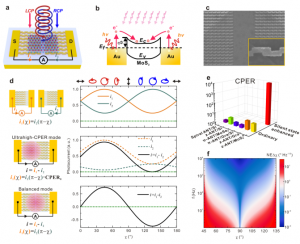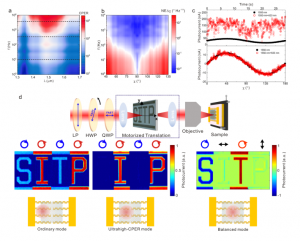On-chip Infrared Circular Polarization Detector with Ultrahigh Discrimination
Polarization, as a primary physical quantity of light, is of great interest to almost all optical sciences and technologies. Along with linear polarization detection, circular polarization (or light ellipticity) detection is essential for chiral molecule distinguishing, vision dehazing, magnetic field sensing, quantum communication, and cryptography. Traditional solutions rely on external optical systems containing polarizers and wave plates, unfavorably increasing the complexity and sizes of light ellipticity detectors.
In recent years, with the trend of miniaturization and integration of devices, many researches have been carried out the research about integrating plasmonic chiral structures directly with photodetection materials to realize compact light ellipticity detectors.
The integrated plasmonic chiral structures not only provide circular polarization discrimination but also enhance the absorptances of the detection materials through an intensified local field. However, the biggest issue is insufficient light ellipticity discrimination. The circular polarization extinction ratio (CPER), defined as the ratio of the responsivity for the light in the principle circular polarization state to that for the light in the orthogonal circular polarization state, is typically below 5. In comparison, the CPER of a conventional circular polarizer is usually above 1000. The key problem is that the photoresponse to the unwanted polarization cannot be efficiently suppressed.
In a new paper published in Light Science & Application, a team of scientists, led by Professor Jing Zhou, Weida Hu, Xiaoshuang Chen, and Wei Lu from State Key Laboratory of Infrared Physics, Shanghai Institute of Technical Physics, Chinese Academy of Sciences, propose the concept of optoelectronic silent state to address the insufficient light ellipticity discrimination of integrated circular polarization detectors. The team design and demonstrate a silent state enhanced on-chip infrared circular polarization detector as a combination of two ordinary integrated circular polarization detectors with enantiomerically opposite ellipticity dependences and opposite photoresponse polarities. The superposition of the two photoresponses leads to an optoelectronic silent state with zero photocurrent and significantly suppressed noise. The silent state can be set at various polarization states by tuning the magnitudes of the two photoresponses for superposition. A singularly high CPER or singularly high sensitivity to light ellipticity change is realized when the silent state coincides with a circular polarization state or a chirality transition point (e.g., horizontal or vertical polarization).
Figure 1 shows the structure and advantages of the integrated circular polarization detector based on photoelectric silent state. The source and drain regions are prepared on the surface of the Au-Al2O3 substrate, and a channel is maintained between the two regions, and the channel material is MoS2. two face-to-face Schottky junctions in resulting from the contact between the source and drain electrodes and MoS2 provide a self-driven and opposite direction optical response. In the near infrared range, the self-driven photocurrents at the MoS2-Au junction are attributed to plasmon resonance induced hot electron injection. The Z-antenna not only enhances the responsivity of the Schottky junction, but also makes the self-driven response in the source and drain electrode regions of the detector appear circular-polarization- dependent due to its selective absorption of circularly polarized light: the response of source strongly to left-handed circularly polarized (LCP) light than to right-handed circularly polarized (RCP) light, while the response of drain to RCP light is stronger than LCP.
The silent state enhanced on-chip infrared circular polarization detector exhibits an ultrahigh circular polarization discrimination ability in the experiment. In fact, the output value of actual test equipment cannot be absolutely zero, and the down limit is the noise (inoise), Therefore, the CPER is redefined as the ratio of the photoresponse under LCP (main polarization) illumination to the noise under RCP (Polarization states that need to be shielded) illumination. As shown in Figure 2, for the ultra-high CPER mode, taking into account the ambient noise and equipment noise, the authors redefine CPER as a function not only of the wavelength but also of the modulation frequency of the incident light. In the ultra-high CPER mode, considering the noise from environment and equipment, the CPER is related to the wavelength and the modulation frequency of the incident light. When the modulation frequency exceeds 1 kHz, the CPER value exceeds 104. In the balanced mode, the optoelectronic silent state was set at the horizontal and vertical linear polarization, showing ultrahigh sensitivity to light ellipticity change. The noise equivalent light ellipticity difference goes below 0.009° Hz−1/2. It is noted that the device working in the balanced mode also exhibits excellent anti-common-mode noise ability.
The single-pixel imaging results demonstrate the potential of the device in the field of infrared circular polarization detection. In the ordinary circular polarization detection mode, it is impossible to completely eliminate the signal of RCP light due to the low CPER. In the ultrahigh CPER mode, the device does not respond to RCP light at all. In the balanced mode, the silent state appears at chirality transition points such as HP and VP, the polarity of the photocurrent indicates the polarization chirality of the incident light: i > 0 (i < 0) for left-handed (right-handed) polarizations, and there is no response to HP and VP light.
In summary, the ultrahigh discrimination of light ellipticity is realized in an on-chip infrared circular polarization detector based on the optoelectronic silent state. The ultracompact size below 50 m and superior performance strongly indicates that the optoelectronic silent state enhanced on-chip circular polarization detectors is a promising upgrade to ordinary integrated circular polarization detectors, and shows great potential to replace conventional circular polarization detectors.
###
References
Funding Information:
This work was supported by the National Key Research and Development Program of China, National Natural Science Foundation of China, Hundred Talents Program of the Chinese Academy of Sciences, Key Deployment Projects of the Chinese Academy of Sciences, Program of Shanghai Academic/Technology Research Leader and Shanghai Municipal Science and Technology Major Project.
DOI: 10.1038/s41377-023-01193-4
Original Source URL: https://doi.org/10.1038/s41377-023-01193-4
About The Light: Science & Applications
The Light: Science & Applications will primarily publish new research results in cutting-edge and emerging topics in optics and photonics, as well as covering traditional topics in optical engineering. The journal will publish original articles and reviews that are of high quality, high interest and far-reaching consequence.
Wendy Chen
TranSpread
+1 865-405-5638
email us here
Legal Disclaimer:
EIN Presswire provides this news content "as is" without warranty of any kind. We do not accept any responsibility or liability for the accuracy, content, images, videos, licenses, completeness, legality, or reliability of the information contained in this article. If you have any complaints or copyright issues related to this article, kindly contact the author above.


